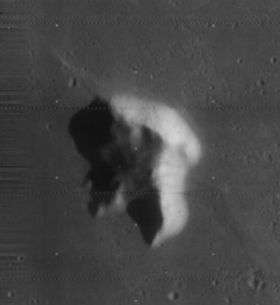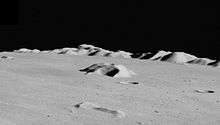Mons Piton
| Mons Piton | |
|---|---|
 Lunar Orbiter 4 image | |
| Highest point | |
| Elevation | 2.3 km |
| Listing | Lunar mountains |
| Coordinates | 40°36′N 1°06′W / 40.6°N 1.1°W |
| Dimensions | |
| Width | 25 km |
| Geography | |
| Location | the Moon |

Mons Piton is an isolated lunar mountain that is located in the eastern part of the Mare Imbrium, to the north-northwest of the crater Aristillus. Due east of Mons Piton is the flooded crater Cassini, and to the west-northwest lies Piazzi Smyth. North and northeast of this massif is the Montes Alpes range, forming the northeast edge of the lunar mare.
The selenographic coordinates of this rise are 40.6° N, 1.1° W, and it has a diameter of 25 km.[1] It is slightly elongated along toward the northwest, with ridge lines to the south, northwest, and west. The peak climbs to a height of 2250 m,[1] typical of the peaks in the Montes Alpes, but much lower than Mons Blanc, which rises to 3.6 km. Because it is an isolated formation on the lunar mare, this peak can form prominent shadows when illuminated by oblique sunlight during the lunar dawn or dusk. It is also known as a location of Transient Lunar Anomalies.[2]
The peak of Piton is cratered from a meteor strike, though the crater can be difficult to observe from earthbound telescopes.[3]
There is a pair of satellite craters on the mare to the south that are named for this peak (see below). To the south-southwest is a low ridge feature in an isolated portion of the mare that is designated Piton Gamma (γ).
Mons Piton was named for a peak on Tenerife Island.[1] The lunar Mons Piton is located in a range known as the Montes Teneriffe.[2][4]

Satellite craters
By convention these features are identified on lunar maps by placing the letter on the side of the crater midpoint that is closest to Mons Piton. Both Piton A and B are to the south of Mons Piton.
| Piton | Latitude | Longitude | Diameter |
|---|---|---|---|
| A | 39.8° N | 1.0° W | 6 km |
| B | 39.3° N | 0.1° W | 5 km |
External Links
- Exposed Layers within Piton B crater
References
<div class="reflist columns references-column-width" style="-moz-column-width: [1] [2] [4] [3]; -webkit-column-width: [1] [2] [4] [3]; column-width: [1] [2] [4] [3]; list-style-type: decimal;">
- 1 2 3 4 5 6 Rükl, Antonín (1996). Atlas of the Moon. Waukesha, Wi.: Kalmbach Publishing Co. p. 50. ISBN 0-913135-17-8.
- 1 2 3 4 5 North, Gerald (2007). Observing the Moon (Second ed.). New York: Cambridge University Press. p. 291. ISBN 978-0-521-87407-6.
- 1 2 3 4 Planck, Andrew (2015). What's Hot on the Moon Tonight: The Ultimate Guide to Lunar Observing. MoonScape Publishing LLC. p. 69. ISBN 978-0-9908769-0-8.
- 1 2 3 4 Antonín Rükl (2012). Sky & Telescope's Field Map of the Moon (Map). Sky & Telescope Media, LLC. ISBN 1931559228.